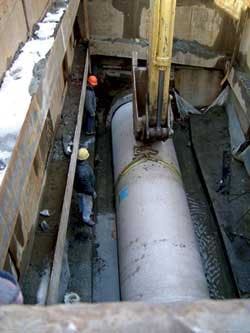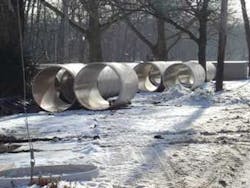Sliplining Restores Failing Sewer Line
By Kimberly Paggioli and Keith Kelly
Elmsford, N.Y., is located in Westchester County midway between White Plains and Tarrytown, 25 miles from New York City. Incorporated in 1910, the town has a colorful history dating back to the early 1700s. As with many older communities, maintaining its charm also requires significant maintenance of an aging infrastructure system.
Westchester County's main line, the Saw Mill Valley Trunk Sewer, was originally constructed in the 1940s and was showing signs of aging. Many preventive repairs had been made over the years to prolong its life. The line traverses the town adjacent to the Saw Mill Parkway, collecting and carrying sewage from the town to the Yonkers Joint Waste Water Treatment Plant.
In December 2002 a major collapse of the pipeline occurred at the intersection of Route 119 and the Saw Mill Parkway. Years of attack from hydrogen sulfide gas had finally taken their toll. The gas was generated in the slower flowing sewerage, then released at more turbulent areas. The brunt of the damage occurred at the point where a force main discharged into the interceptor sewer.
The county quickly stabilized the collapse to maintain the service by allowing flow to continue through the pipe. They engaged the engineering firm Camp Dresser & McKee (CDM) of Cambridge, MA, to assist them in a further evaluation of the pipe's condition. The goal was to find a solution that would extend the life of the interceptor sewer. Field investigations included closed circuit video inspection of the downstream pipe that revealed significant deterioration affecting several pipe sections totaling approximately 1,100 feet.
Three possible solutions were evaluated including open cut replacement and two rehabilitation methods. The first rehab option would have required bypass pumping in order to work on the interceptor while it was dry. The second rehab possibility was to slipline the pipe without interrupting the flow. The ultimate decision was affected by such factors as the risk and hassle of bypass pumping, the resulting disruption to the local traffic and the capital cost. Sliplining "live" was selected.
Corrosion Resistance Needed
Contract documents were developed around the chosen alternative. The only product that was specified for this sliplining method was Hobas centrifugally cast, fiberglass reinforced, polymer mortar (CCFRPM) pipe. The reasons included its resistance to sulfuric acid. Hobas pipes are tested in accordance with ASTM standards in a sulfuric acid environment.
When CDM designed the liner pipe, they gave no consideration to the existing concrete host pipe because of its deteriorated condition. The county had faith in Hobas since they had previous experience with the product. Years earlier, the lower end of the 30-inch diameter force main that discharged into the interceptor sewer had been relined with the company's 24-inch diameter sliplining pipe. This line, which was rehabbed in 1997 as part of the Tarrytown Extension project, is still performing perfectly.
Greatest Flow Recovery
The existing sewer segments were 60- and 66-inch diameter; therefore, 54-inch and 60-inch diameter liner pipes were chosen. This downsizing would allow for a design clearance of one inch between the host ID and the liner OD. A bell-spigot joint that is flush on both the exterior and interior was used to provide the greatest clearance between the existing concrete host sewer and the outside diameter of the joint, which is typically the area with the tightest fit.
CDM completed a hydraulic analysis to determine if the reduced diameter would also diminish the interceptor's flow capacity.
"We performed a hydraulic analysis of the sewer, comparing present conditions to the new relined sewer, and even with the decreased diameter found negligible decreases in flow capacity," said Chris Patackis, environmental engineer with the New York office of the engineering firm.
The smooth, Manning's .009, interior of the CCFRPM pipes allows for substantial flow recovery in most sliplining applications.
The pipe can be inserted in high or low flow and pushed up stream or down. In this case, the segmented, gasket-sealed pipes allowed for live insertion.
"There was no option to bypass flow from this interceptor sewer and at times the flow was within six inches of the crown of the pipe," said Richard Palmer, PE, with Northeast Remsco Construction, of Toms River, N.J.
The pipe also gave the contractor flexibility in the pushing directions and pit locations. This was a great benefit since the existing 66-inch line made several direction changes and varied in diameter along the project alignment. The line was located 15 feet deep along several highly traveled roadways requiring that the installation pit locations be chosen carefully.
The project was rather complex even though it was fairly small, consisting of 936 linear feet of 60-inch and 124 feet of 54-inch pipe plus a variety of closures and fittings. Because of the complexity and other reasons, the Westchester Department of Public Works required that a Hobas representative be available on site during the entire project. Hobas field service personnel were there at the beginning of the job and representatives including the area manager were in constant contact with the contractor to provide assistance when it was needed.
"There were lots of obstacles to overcome on this project," Palmer said.
Aside from the alignment changes, and poor condition of the host pipe, another obstacle was the removal of the broken pieces of concrete from within the host. A previous failure in the line had driven large pieces of concrete downstream during high flow conditions. The contractor needed to remove the debris to prevent future blockage of flow and to facilitate installation of the liner pipe.
A third obstacle appeared when the contractor discovered that the host pipe had an alignment change near the originally planned pushing pit. A new pit was constructed and Hobas provided several short pieces with closure couplings to reline the bend. The balance of the push was completed from this pit.
Once installation was complete, the line was grouted and inspected. The annulus at each end of each pipe run was bullheaded. Then, cellular grout was pumped into the annular space between the host pipe and the sliplined pipe. A post-construction video inspection and videotape were required to verify the complete and proper installation of the pipe. The project was started in December 2003 and despite the winter weather, the project was substantially complete by February 2004.
About the Author: Kimberly Paggioli, PE, is Marketing Manager with Hobas Pipe USA. Keith Kelly, PE, is a Vice President at Camp Dresser & McKee. Paggioli may be contacted by calling 800-856-7473.



